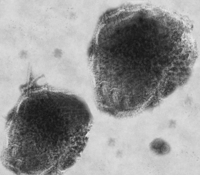Chimeravirus: Difference between revisions
Slonczewski (talk | contribs) No edit summary |
No edit summary |
||
| Line 1: | Line 1: | ||
{Curated} | |||
<small>This page has been tagged '''[[Microbial Science Fiction]]'''. For factual science see '''[[Microbial Biorealm]]'''.</small> | <small>This page has been tagged '''[[Microbial Science Fiction]]'''. For factual science see '''[[Microbial Biorealm]]'''.</small> | ||
---- | ---- | ||
Revision as of 18:10, 3 September 2010
{Curated} This page has been tagged Microbial Science Fiction. For factual science see Microbial Biorealm.
This article is on the biology of the Chimeravirus. For history, see the Great Pandemic of 2049.
Baltimore Classification
Higher order taxa
Viruses; Retro-transcribing viruses; Chimeraviridae
Genera
Chimeravirus
Description and Significance
Chimeravirus, "the virus that shook the world", was the cause of over 8 billion deaths in the Great Pandemic of 2049. A genetic hybrid of Respiratory Syncytial Virus, Ebolavirus, and Human Immunodeficiency Virus, Chimeravirus was created and released by the Christian extremist group 4 Horsemen. Within six months, nearly the entire world population was dead. The remaining population of around 100 million people were saved due to the Asamov Immuno-Supplementation Microbots. The name Chimeravirus refers to the mythological Chimera, which was made of the parts of multiple animals.
Classification of Chimeravirus was difficult, due to the combination of genes. The virus was eventually classified in Group VI due to the reverse transcription of RNA that occurs during reproduction.
Genome Structure
"The genome of chimeravirus is dimeric, unsegmented and contains a single molecule of linear DNA. The genome is -RT and a positive-sense, single-stranded RNA. Minor species of non-genomic nucleic acid are also found in virions. The encapsidated nucleic acid is mainly of genomic origin but virions may also contain nucleic acid of host origin, including host RNA and fragments of host DNA believed to be incidental inclusions. The complete genome of one monomer is 7000-11000 nucleotides long. The 5'-end of the genome has a methylated nucleotide cap with a cap sequence type 1 m7G5ppp5'GmpNp. The 3'-terminus of each monomer has a poly (A) tract and the terminus has a tRNA-like structure." (See Retroviridae and source: ICTVdB)
Virion Structure of a Chimeravirus
"Chimeravirus virions consist of an envelope, a nucleocapsid, and a matrix protein. Virions are large and have a complex construction. They are spherical to pleomorphic, and can range from 150-200 nm in diameter and 1000-10000 nm long. The envelope has spike-like projections spaced widely apart and evenly covering the surface. The surface projections are embedded in a lipid bilayer. The nucleocapsid is 600-800 nm(-1000 nm, depending on the genus), 13-18 nm in diameter, and has helical symmetry." (See Paramyxoviridae and source: ICTVdB)
Reproduction Cycle of a Chimeravirus in a Host Cell
"Chimeravirus virions enter host cells through interaction between a virally-encoded envelope protein and a cellular receptor. Viral RNA is transcribed into a DNA copy by the enzyme reverse transcriptase which is present in the virion. The viral DNA copy is integrated into, and becomes a permanent part of, the host genome. This integrated DNA is referred to as a provirus. The host cell's transcriptional and translational machinery expresses the viral genes. The host RNA polymerase II transcribes the provirus to create new viral RNA, which is then transported out of the nucleus by other cellular processes. A fraction of these new RNAs are spliced to allow expression of some genes, while others are left as full-length RNAs. Viral proteins are synthesized by the host cell's translational machinery. Virions are assembled and bud from the host cell." (See Retroviridae and source: Hu and Pathak)
Viral Ecology & Pathology
Chimeravirus is transmitted via airborne vector. The infection happens in “waves,” as the virus first attacks the T4 lymphocytes, then runs rampant through the body once the immune system has been suppressed. This second wave of the infection causes hemorrhagic fever similar to the symptoms caused by the Filoviridae. Time from first infection to onset of symptoms is approximately 3-4 weeks. Infected persons are able to spread the infection before symptoms are apparent. The death rate for the virus is close to 100% for non-immuno-boosted individuals.
References
Baker et al. "Reproduction of Chimeravirus similar to Retroviridae." Journal of Virological Studies 447.6 (2050): 4008-4015.
Peters et al. "Identification of a new reverse-transcribing RNA virus in a new family: the Chimeraviridae." Journal of Virological Studies 447.5 (2049): 3327-3340.
Smalls and Welk. "New hybrid virus difficult to classify." Virology Online 567.2 (2049): 211-221.
This page has been tagged Microbial Science Fiction.

